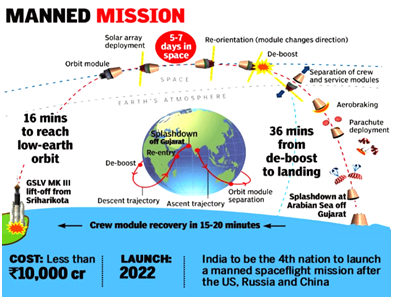

21th July 2022 (7 Topics)
Context
The Indian Space Research Organisation (ISRO) has set new deadlines for major missions, with its first solar mission and third lunar mission set to take place in the first quarter of 2023.
Background
- The Indian space agency had in 2019 announced its plans to set up its own space station in “five to seven years” after successfully launching its first human spaceflight mission.
- The first milestone for the Gaganyaan mission was also decided to be undertaken in the last quarter of 2022 which will be the first abort demonstration mission.
- The scientific missions slated for 2023 have been repeatedly pushed back since 2020 amidst the pandemic that slowed down all activities of the space agency, including the number of launches.
- There were only two launches in 2020 and 2021.
About
Gaganyaan
- Gaganyaan is a mission by the Indian Space Research Organisation (ISRO).
- It has Three flights will be sent into orbit.
- There will be two unmanned flights and one human spaceflight.
- The Gaganyaan system module, called the Orbital Module will have three Indian astronauts, including a woman.
- It will circle Earth at a low-earth-orbit at an altitude of 300-400 km from earth for 5-7 days.

- Launch: GSLV Mk III, also called the LVM-3 (Launch Vehicle Mark-3,) the three-stage heavy lift launch vehicle, will be used to launch Gaganyaan as it has the necessary payload capability.
Chandrayaan-3
- The Chandrayaan-3 mission is a follow-up of Chandrayaan-2 of July 2019, which aimed to land a rover on the lunar South Pole.
- The subsequent failure of the Vikram lander led to the pursuit of another mission to demonstrate the landing capabilities needed for the Lunar Polar Exploration Mission proposed in partnership with Japan for 2024.
- Geosynchronous Satellite Launch Vehicle Mark-III was developed by Indian Space Research Organisation (ISRO), is a three-stage vehicle, designed to launch communication satellites into geostationary orbit.
- It has a mass of 640 tonnes that can accommodate up to 8,000 kg payload to Low Earth Orbit (LEO) and 4000 kg payload to GTO (Geo-Synchronous Transfer Orbit).
Upcoming Developments by ISRO
- XpoSat: It will be India’s second astronomical observatory in space after the
- It will help in studying cosmic x-rays.
- Shukrayaan Mission: The ISRO is also planning a mission to Venus, tentatively called Shukrayaan.

More Articles



